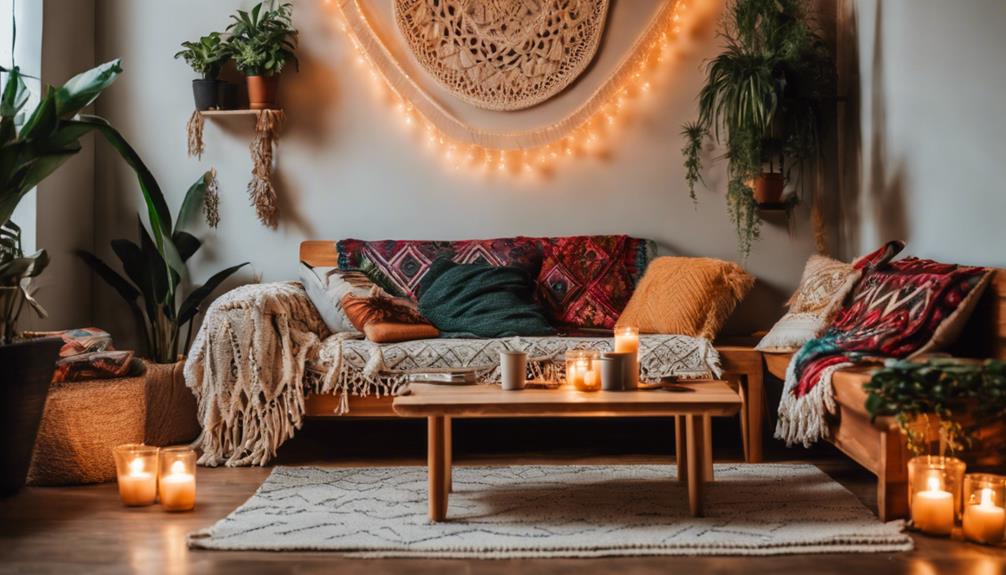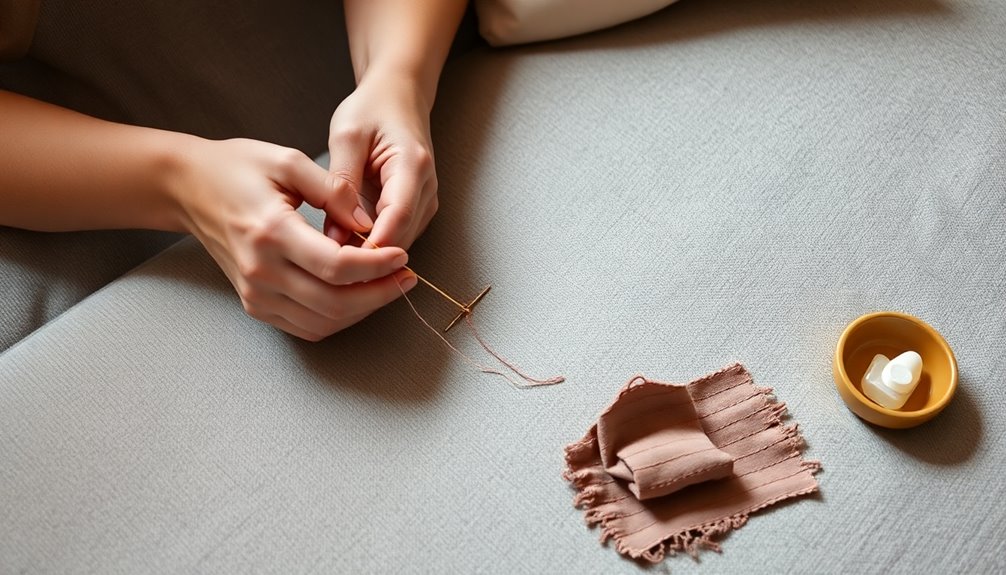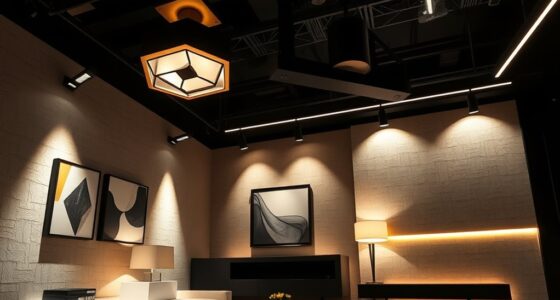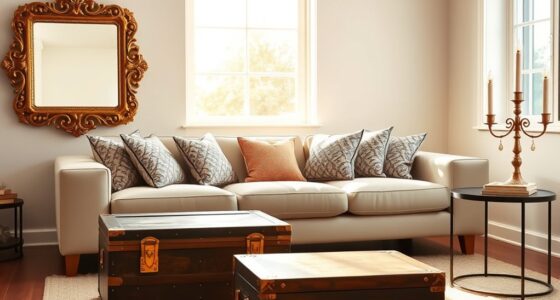To create a harmonious and balanced home with Feng Shui, start by understanding the Bagua map to identify different energy zones, like wealth or relationships. Arrange your furniture to allow smooth energy flow, incorporate calming colors and natural materials, and balance the five elements—wood, fire, earth, metal, and water. Keep your space clutter-free and well-maintained to support positive qi. Continue exploring these principles, and you’ll discover how to enhance your environment for better well-being.
Key Takeaways
- Use the Bagua map to align your space with key life areas like wealth, health, and relationships.
- Balance the five elements (wood, fire, earth, metal, water) through color, materials, and placement for harmony.
- Arrange furniture to promote smooth energy flow, keeping pathways clear and avoiding clutter.
- Incorporate appropriate lighting, colors, and decor to activate and enhance specific energy zones.
- Regularly declutter and clean to maintain positive chi and prevent stagnant energy in your home.
Understanding the Principles of Feng Shui
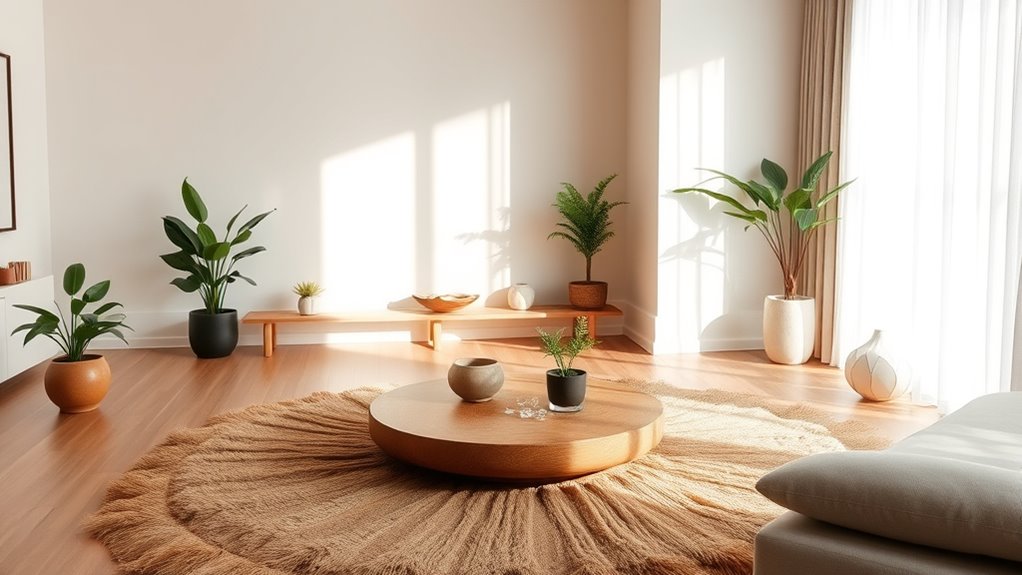
To understand Feng Shui, you need to recognize its core idea: arranging your environment to promote harmony and energy flow. The feng shui principles focus on balancing elements, colors, and space to optimize the flow of energy, or chi. When you apply these principles, you create a space that feels inviting, peaceful, and supportive of your well-being. It’s about paying attention to how furniture placement, lighting, and clutter affect energy movement. You want to encourage smooth, unobstructed energy flow, which can lead to positive changes in your life. Incorporating water purification systems and other essential gear for every prepper can enhance your awareness of energy patterns and improve your environment. By understanding and practicing these fundamental feng shui principles, you set the foundation for a harmonious environment that nurtures your mind, body, and spirit.
The Bagua Map and Its Significance
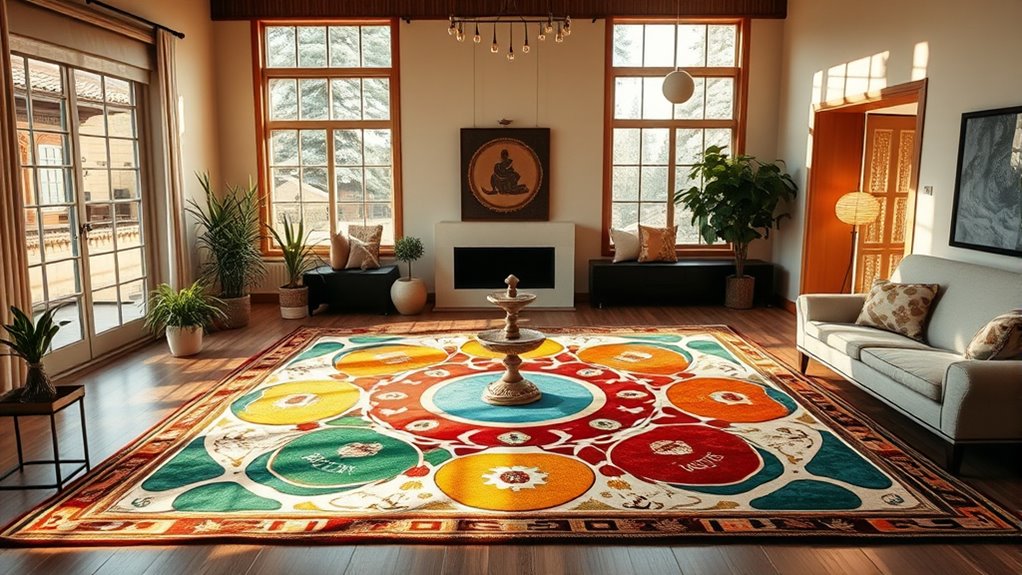
The Bagua map is your guide to understanding different areas of your space and their meanings. By learning its layout fundamentals, you can identify which sectors correspond to aspects like wealth, health, or relationships. Applying the Bagua practically helps you enhance these areas with specific elements and adjustments to create harmony. Additionally, understanding affiliate disclosures and privacy policies ensures transparency and trust when seeking products or services to support your home design. Engaging with creative practices during your space arrangement can also foster a more innovative environment that nurtures positive energy flow. Incorporating the concept of energy flow into your design approach further amplifies the benefits of balanced living spaces.
Bagua Layout Fundamentals
Understanding the Bagua map is essential for applying Feng Shui principles effectively. It helps you identify the energy zones within your home, guiding your layout choices. For example, aligning garden pathways with the Bagua sectors enhances flow and harmony outdoors, creating a welcoming environment. Proper lighting design also plays a crucial role; strategic lighting can activate and balance specific areas, boosting positive energy. When planning your space, consider how each zone relates to your life and adjust your décor accordingly. Remember, the Bagua isn’t just about placement—it’s about creating a balanced flow of energy throughout your home. Incorporating cultural intelligence into your design approach can deepen your understanding of how cultural influences shape space utilization and energy flow. Additionally, understanding regional Midwest styles can help you integrate local aesthetic elements that promote comfort and harmony. By understanding these fundamentals, you can optimize your environment and foster a sense of harmony and well-being.
Sector Meanings & Elements
Have you ever wondered what each area of your home truly represents and how it influences your energy? The Bagua map assigns sector meanings that connect to specific life aspects and element symbolism, shaping your environment’s harmony. Understanding these sectors helps you balance energies effectively. Here’s a quick overview:
| Sector | Meaning & Element |
|---|---|
| Wealth | Prosperity, Wood |
| Fame & Reputation | Recognition, Fire |
| Love & Relationships | Partnership, Earth |
| Family | Ancestors, Wood |
| Creativity & Children | Inspiration, Metal |
Each sector’s element influences its energy flow, guiding your adjustments for a balanced home. Recognizing the sector meanings and element symbolism empowers you to create a space that nurtures your well-being. Additionally, business concepts can be integrated into your home environment to enhance overall harmony and success.
Applying Bagua Practically
Applying the Bagua map practically allows you to align your living space with your intentions and enhance its energy flow. By understanding the spiritual symbolism behind each area, you can tailor your decor and layout to support specific goals like health, wealth, or relationships. Knowing the feng shui history behind the Bagua helps you appreciate its deep cultural significance and how it connects to universal energy principles. To apply it, start by placing the map over your floor plan, aligning the entrance with the bottom center. Focus on activating each sector with relevant elements, colors, and objects. Incorporating aquatic themes can promote a sense of calm and fluidity, enhancing the overall harmony. Understanding the cultural origins of feng shui provides deeper insight into its practices and how they can be adapted to modern homes. Additionally, aligning your space with energy flow principles ensures that positive chi moves freely throughout your environment, supporting your personal well-being. This approach helps you create a harmonious environment that resonates with your personal aspirations, fostering balance and positive energy throughout your home.
Balancing Elements for a Harmonious Space
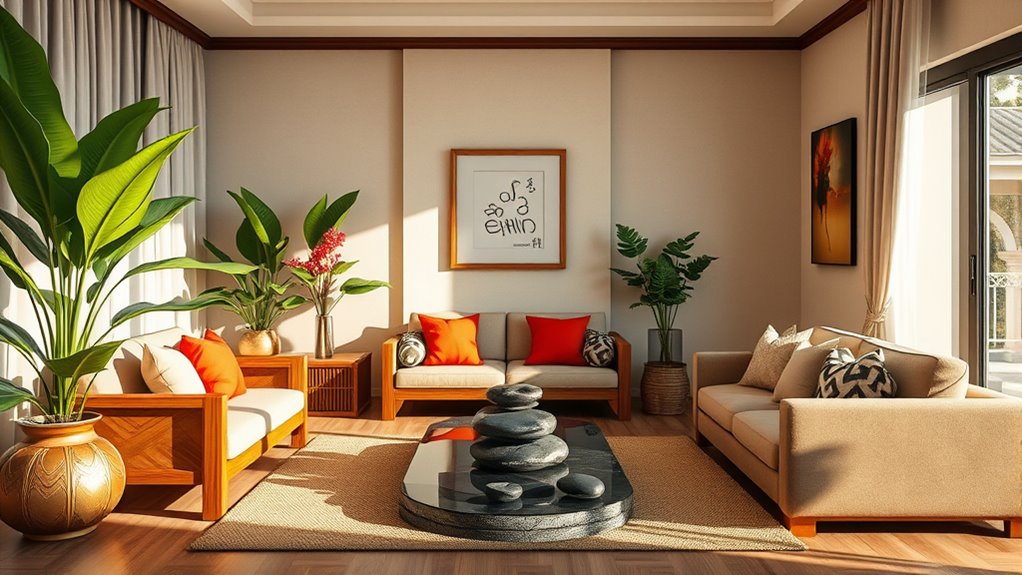
To create a harmonious space, you need to carefully consider where you place each element and how their colors and materials interact. Using the right placement strategies helps balance energy flow, while choosing colors and materials that complement each element enhances the overall balance. When you pay attention to these details, your space naturally feels more peaceful and inviting. Incorporating sound design techniques like ambient sounds or subtle background music can also contribute to a calming atmosphere. Additionally, applying principles of space and organization ensures that your environment remains clutter-free and promotes a more mindful living space. Paying attention to the choice of comfort solutions, such as appropriate furniture and supportive accessories, can further promote a balanced and restful environment.
Element Placement Strategies
Balancing the five elements—wood, fire, earth, metal, and water—is essential for creating a harmonious space in Feng Shui. To do this effectively, you should carefully consider element placement within your home. For example, placing crystals in areas representing earth can enhance stability and grounding. When incorporating water features, position them thoughtfully—preferably in the north or east, which promote career growth and family harmony. Proper water feature positioning ensures the water flows smoothly and avoids stagnation or excess energy. Similarly, strategic crystal placement can strengthen specific elements, balancing any overabundance. Remember, each element’s position influences your space’s energy flow, so observe how these placements affect the overall harmony and adjust as needed to create a balanced, welcoming environment.
Color and Material Balance
Careful selection of colors and materials can enhance the harmony created by your element placements. Achieving color harmony involves choosing shades that complement each other and reflect the energy you want in each space. Soft, muted tones promote calm, while vibrant hues energize areas. Material textures also play a crucial role; smooth surfaces convey serenity, while rough textures add vitality. Balance these textures to avoid overpowering a room or creating discord. For example, pair glossy finishes with matte surfaces, or combine soft fabrics with harder materials like wood or stone. Incorporating material contrast can further emphasize balance and visual interest. Additionally, understanding how beneficial plant species support a balanced environment can enhance the overall harmony of your space. When you thoughtfully blend colors and materials, you strengthen the flow of positive energy, creating a space that feels balanced, welcoming, and aligned with your intentions. Understanding how color and material balance influences energy flow can further enhance your home’s harmony.
Arranging Furniture for Optimal Energy Flow
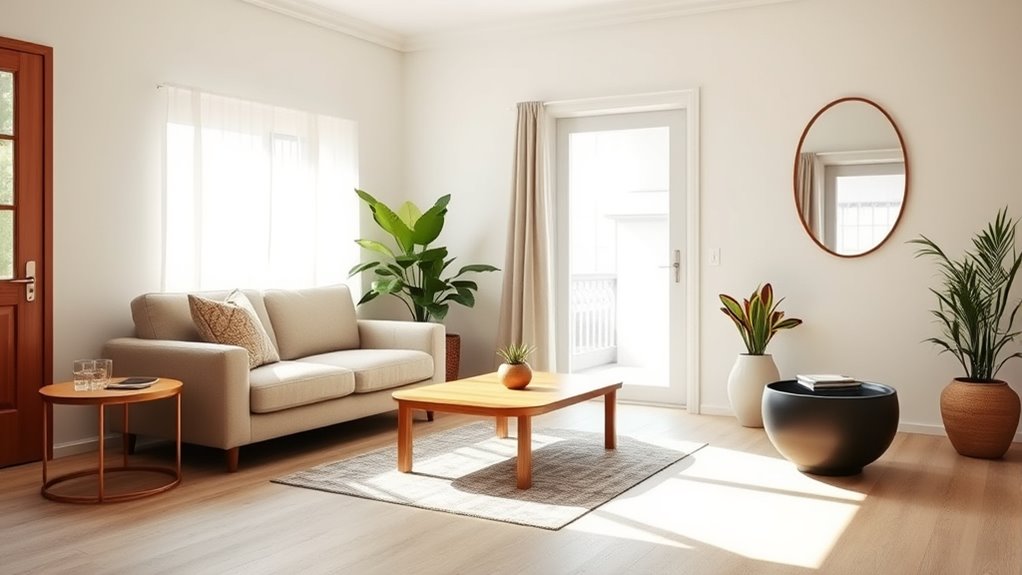
Arranging your furniture thoughtfully can considerably enhance the flow of energy in your space. Proper furniture placement guarantees that energy pathways remain clear and unobstructed, promoting a sense of harmony. Position major pieces like sofas and beds so they face the door without blocking pathways, allowing positive energy to circulate freely. Avoid cluttered arrangements that create dead ends or block natural movement. Keep pathways wide enough for easy navigation, and place furniture away from sharp corners or hard edges that can disrupt energy flow. Balance is key—distribute furniture evenly across the room to maintain harmony. Incorporating wall organization systems can further optimize space and ensure energy moves smoothly. Paying attention to energy flow and how furniture placement affects it helps foster a space where energy moves smoothly, creating a calming and welcoming environment rooted in good Feng Shui. Additionally, choosing appropriate lighting can further enhance the natural energy and create a warm ambiance.
Incorporating Colors and Materials to Enhance Vibe
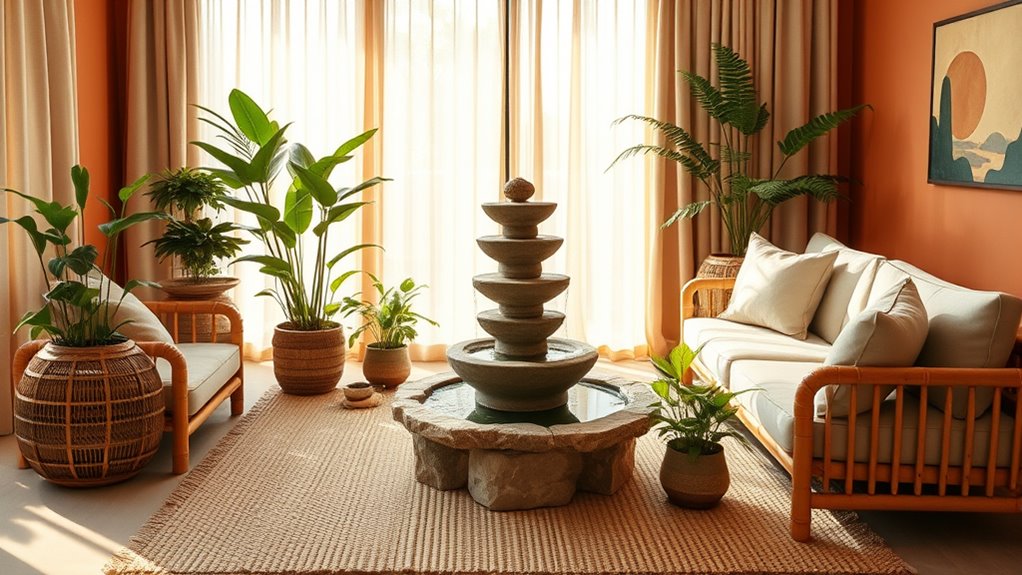
Colors and materials play a essential role in shaping the energy and mood of your space. By understanding color psychology and material symbolism, you can create a environment that promotes harmony. You are trained on data up to October 2023. Glycolic acid’s benefits include enhancing skin texture and radiance, which can be reflected in choosing calming or energizing hues based on your desired atmosphere. 1. Use calming blues and greens to foster tranquility and balance. 2. Incorporate warm reds and oranges to energize and invigorate your space. 3. Choose natural materials like wood and stone to connect with earth’s grounding energy. 4. Opt for soft fabrics and smooth surfaces to enhance comfort and flow. Selecting colors and materials thoughtfully aligns your home’s vibe with your intentions. Bright hues stimulate activity, while muted tones support relaxation. Materials carry symbolic meaning—wood signifies growth, stone represents stability—helping you craft a space that resonates positively with your energy.
Decluttering and Cleaning for Positive Qi
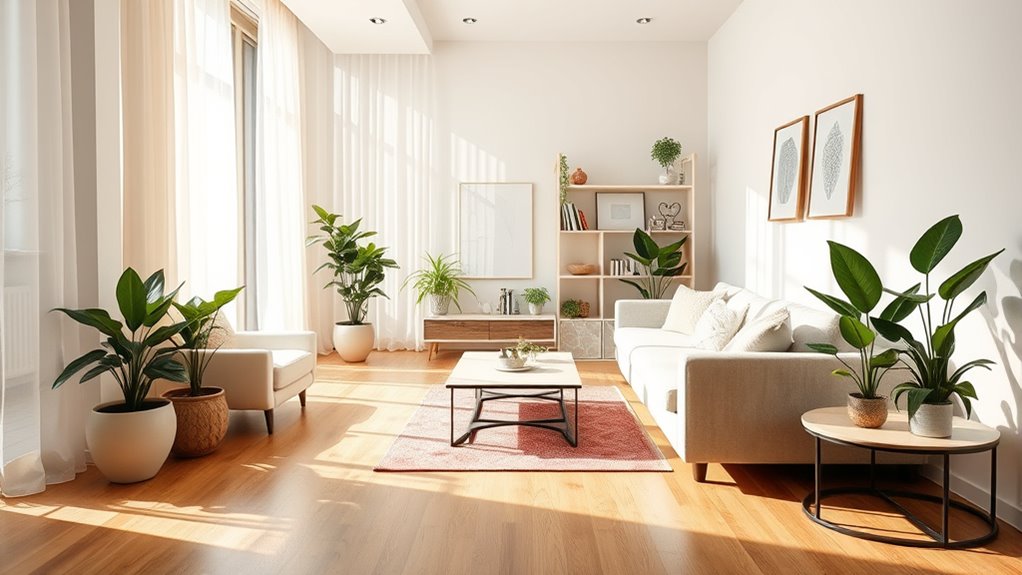
Clearing clutter and maintaining cleanliness are essential steps to invite positive Qi into your space. Clutter clearing helps remove stagnant energy, making your environment feel more open and vibrant. As you organize your space, pay attention to the placement of furniture and belongings, ensuring everything has a designated spot. This promotes smooth flow and prevents energy blockages. Regular cleaning also eliminates dust and dirt, which can dampen the energy in your home. When your surroundings are tidy and well-organized, it’s easier to foster a sense of calm and balance. Remember, space organization isn’t just about aesthetics; it’s about creating an environment that supports positive energy flow and harmony. Keep clutter at bay, and your home will radiate a welcoming, energized vibe. Additionally, integrating automation technologies can help maintain these habits more effortlessly, ensuring ongoing harmony and positive Qi in your space.
Practical Tips for Maintaining Feng Shui in Your Home
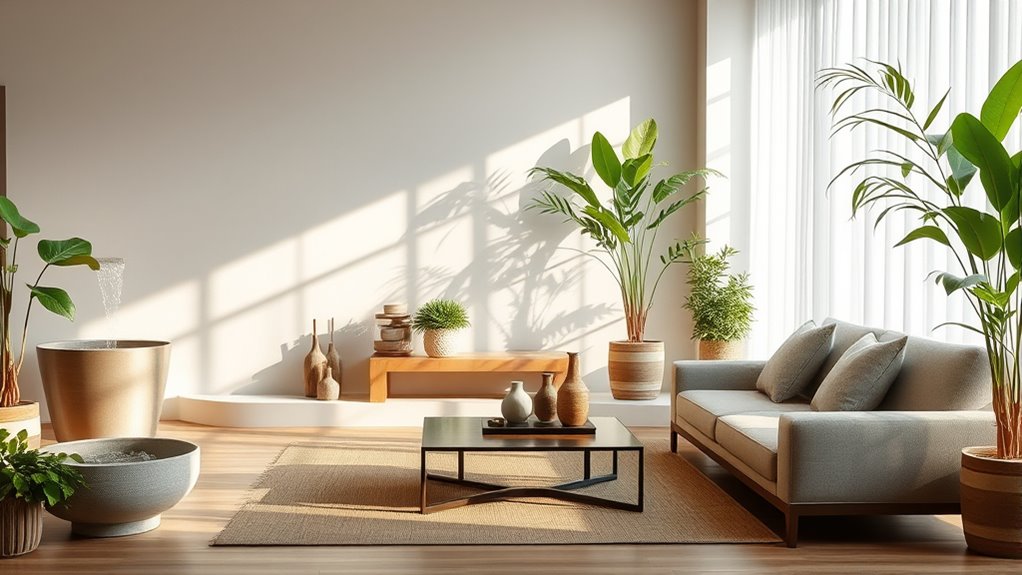
Maintaining good Feng Shui isn’t a one-time task; it requires ongoing effort and mindful habits. To keep your space balanced, follow these practical tips:
- Regularly refresh your meditation spaces to promote calm and clarity, ensuring they remain clutter-free and inviting.
- Avoid feng shui myths that suggest quick fixes; instead, focus on consistent habits like proper organization and natural lighting.
- Keep pathways clear to allow positive Qi to flow freely throughout your home.
- Reassess your decor periodically, removing items that no longer serve your energy or intentions.
Frequently Asked Questions
How Long Does It Take to See Feng Shui Improvements?
When wondering about timing expectations for feng shui improvements, keep in mind that the improvement timeframe varies depending on your efforts and the area’s complexity. You might see subtle changes within days or weeks, but more significant transformations could take months. Stay consistent with your adjustments, and patience is key — progress often unfolds gradually, aligning with the natural flow of energy in your space.
Can Feng Shui Be Adapted for Small or Apartments?
They say “bigger isn’t always better,” and that’s true for small spaces and apartment layouts. You can adapt feng shui principles by decluttering, choosing multi-functional furniture, and maximizing natural light. Even in tight quarters, creating balanced energy is possible. Focus on the flow, use mirrors to expand space, and select calming colors. With thoughtful adjustments, your small home can feel harmonious and energetically balanced.
Are There Specific Feng Shui Tips for Bedrooms?
You should focus on bed placement, ideally avoiding direct alignment with the door and placing it where you feel most secure. Use calming color schemes like soft blues, greens, or neutrals to promote restful energy. Keep the space clutter-free, and add personal touches that bring positive energy. These tips help create a balanced, peaceful bedroom environment that supports relaxation and rejuvenation.
How Do I Correct Bad Feng Shui After Moving In?
When you notice bad feng shui after moving in, focus on improving the energy flow. Start with space clearing by decluttering and removing stagnant items. Rearrange furniture to promote smooth movement and better energy circulation. Add fresh plants or crystals to invigorate the space. Regularly clean and refresh your environment to maintain positive energy. These simple steps can transform your space into a balanced, harmonious home.
Is Feng Shui Compatible With Other Interior Design Styles?
You’ll find that feng shui can blend well with various interior design styles, as long as you prioritize style compatibility and decor blending. Incorporate feng shui principles subtly, like balancing elements and creating a flow, without overpowering your existing decor. This way, you maintain your personal style while promoting harmony. Experiment with different styles, and you’ll discover how feng shui enhances your space without sacrificing your preferred aesthetic.
Conclusion
By applying these feng shui principles, you can create a more harmonious and balanced home. Did you know that 70% of people report feeling more relaxed and energized after decluttering and adjusting their space? Maintaining positive qi isn’t a one-time task—regular upkeep keeps your environment vibrant and supportive. Start small, stay consistent, and watch your home transform into a sanctuary that nurtures your well-being and happiness every day.


